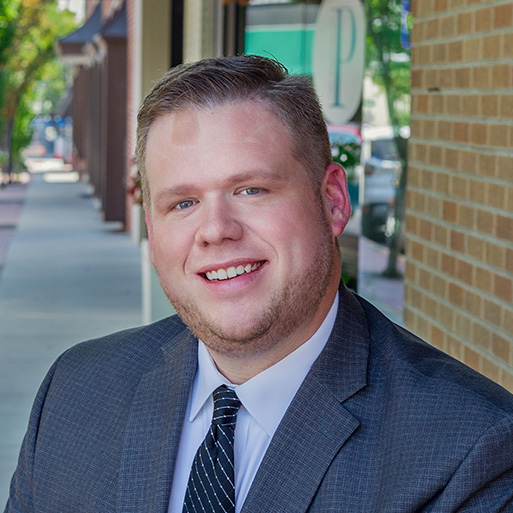What Happens if I Take a Bigger RMD?
Attorney Benjamin E. Long
Estate Planning and IRA Distribution Strategist
Benjamin Long, a prominent estate planning attorney at Schlagel Long, LLC, specializes in intricate retirement planning, with a focus on optimizing Individual Retirement Account (IRA) distributions. His expertise extends to navigating the complexities of Required Minimum Distributions (RMDs), ensuring that his clients make informed decisions about their retirement and estate planning needs.
Drawing from his extensive legal background, Benjamin has developed a keen insight into the interplay between estate planning and retirement finances. His blog post, "Gift Your House To Your Children: What Happens if I Take a Bigger RMD?" highlights his proficiency in handling sophisticated issues related to IRAs and RMDs. In this insightful post, he addresses the potential pitfalls of adhering to minimum IRA distributions and the advantages of considering larger RMDs for certain clients.
Benjamin's approach is unique in that he doesn't just look at the legal aspects but also delves into the financial implications of estate planning decisions. He emphasizes the importance of understanding one's tax bracket, income sources, and the financial standing of beneficiaries when making RMD decisions. This comprehensive perspective is crucial for clients, particularly those with substantial assets in IRAs.
A graduate of Washburn University Law School, where he received a Certificate in Advocacy and was inducted into the Order of the Barristers, Benjamin combines his legal acumen with a practical understanding of tax implications. His earlier education in Biology from Kansas State University adds to his analytical skills, enabling him to dissect complex estate and tax planning scenarios with ease.
Benjamin's commitment to his clients extends beyond the courtroom and the office. He is actively involved in educating the next generation of lawyers as an adjunct faculty member at Washburn Law School and as head coach of the Kansas State University Mock Trial Team. Recognized as a Super Lawyer Rising Star and recipient of the Martindale-Hubbell Client Distinction Award, Benjamin's accolades reflect his dedication to his field and his clients.
In his personal life, Benjamin enjoys time in Olathe, Kansas, with his family, cherishing the values he instills in his professional practice. His blog and professional work stand as testaments to his belief in preparing for the future, not just for his clients, but also for his own family.

Why Taking the Minimum RMD Can be Costly
Benefits of Taking a Larger RMD
Looking at the broader picture might lead you to go bigger with your RMDs. For example, Bill and Betty are ages 75 and 71. Bill has an IRA worth $850,000. Their retirement income consists of a pension totaling $34,000, dividends of $8,000 and combined Social Security benefits of $77,000. Bob’s 2021 IRA RMD is $37,118. Using the standard deduction of $28,100 (for a married couple where both are over age 65 plus a $300 charitable contribution deduction), their taxable income is $116,468. Federal taxes are $16,560.
Bill and Betty could recognize another $65,000 of ordinary income from his IRA before they land in the 24% tax bracket. In 2022, Betty will have to start taking RMDs on her IRA—did we mention that her IRA is worth $1.5 million?—which will bump them into the 24% tax bracket. Bill should take another $64,000 from his IRA, filing up the 22% ordinary income bracket and reducing his RMD for 2022.
Another example: Alan Smithers is 81 and remarried ten years after his first wife passed. His IRA is worth $1.3 million, and his daughter is the beneficiary. His IRA RMD is $66,000 and he intends to be generous with charity this year, using about $30,000 for a Qualified Charitable Distribution (QCS). Based on a projection of his 2021 tax return, Alan could take another $22,000 from his IRA, taxable at 12%. His daughter Daphne is 51, has a high income and significant assets. He should consider filling up his own 12% marginal ordinary income bracket, because when Daphne starts taking her own beneficiary distributions, she’ll be facing high taxes.
Factors to Consider When Making RMD Decisions
Here’s what you need to consider when making RMD decisions:
Your tax bracket. How much more income can you realize while staying within your current tax bracket? Taxpayers in the 10-12% brackets should be extra careful of maxing out on ordinary income.
Your income. What does 2022 look like for your income? Will there be other sources of income, such as an inherited IRA, spouse’s IRA RMD, or annuity income to be considered?
Beneficiaries. How does your own tax rate compare with the tax rates of your beneficiaries? If you have a large IRA and your children have high incomes, could an inheritance push them into a higher tax bracket?
Medicare Premiums. Increases in income can lead to higher Medicare Part B and D premiums in coming years, so also keep that in mind.
Taking a Broader View
It’s best to take the broader view when planning for RMDs and taxes. A short-sighted approach could end up being more costly for you and your heirs.
Reference: Kiplinger (Nov. 23, 2021) “Should You Take an Extra Big RMD This Year?”
Related Posts
What Happens if I Take a Bigger RMD?
What Happens If You Don’t Name Beneficiaries?
How To Be Smart About a Financial Windfall
Inherited IRAs Require Careful Handling
Social Security and Medicare and the Impact on Retiree Taxes
Five Top Reasons To Add Beneficiaries to Investment Accounts
Elder Financial Abuse Fraud Occurs, When No One’s Watching
Are You Making the Most of the Secure and Cares Acts?
Tapping an Inherited IRA?
Elder Abuse Continues as a Billion-dollar Problem
